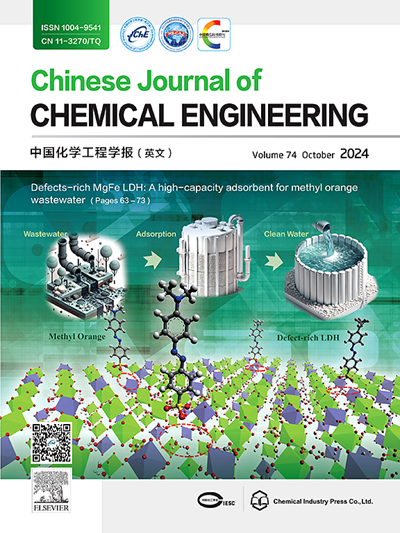Synergistic effect of Co0 with Cu11In9 intermetallic compound enhancing catalytic performance of CO2 hydrogenation to methanol
IF 3.7
3区 工程技术
Q2 ENGINEERING, CHEMICAL
引用次数: 0
Abstract
CO2 hydrogenation to methanol is a critical technology for hydrogen energy conversion and a promising approach to mitigate the energy crisis and greenhouse effect. However, developing highly selective catalysts remains a major challenge for its practical application. Herein, we synthesize an efficient CoCuInO-r catalyst with Cu11In9 and Co0 dual sites on In2O3 via a sol-gel method. The Cu11In9 intermetallic compound enhances H2 adsorption capacity and strength, and increases oxygen vacancy concentration on the catalyst surface, thereby improving CO2 activation and hydrogenation efficiency. Meanwhile, Co0 suppresses the desorption of the ∗CO species, facilitating its further hydrogenation to methanol. In-situ DRIFTS experiments indicate that the CO2 hydrogenation to methanol over CoCuInO-r follows the formate pathway. Compared with CuInO-r (containing Cu11In9 on In2O3), CoCuInO-r exhibits a ∼20% increase in methanol selectivity and a 2-fold higher methanol space-time yield, reaching 7.68 mmol·g−1·h−1 at 300 °C and 4 MPa.

Co0与Cu11In9金属间化合物的协同作用增强了CO2加氢制甲醇的催化性能
二氧化碳加氢制甲醇是氢能转化的关键技术,也是缓解能源危机和温室效应的重要途径。然而,开发高选择性催化剂仍然是其实际应用的主要挑战。本文采用溶胶-凝胶法在In2O3上合成了Cu11In9和Co0双位点的高效CoCuInO-r催化剂。Cu11In9金属间化合物增强了H2的吸附能力和强度,增加了催化剂表面氧空位浓度,从而提高了CO2的活化和加氢效率。同时,Co0抑制了* CO的解吸,使其进一步加氢生成甲醇。原位DRIFTS实验表明,CoCuInO-r上CO2加氢制甲醇遵循甲酸途径。与Cu11In9在In2O3上的cucuino -r相比,CoCuInO-r的甲醇选择性提高了约20%,甲醇空时产率提高了2倍,在300℃、4 MPa条件下达到7.68 mmol·g−1·h−1。
本文章由计算机程序翻译,如有差异,请以英文原文为准。
求助全文
约1分钟内获得全文
求助全文
来源期刊

Chinese Journal of Chemical Engineering
工程技术-工程:化工
CiteScore
6.60
自引率
5.30%
发文量
4309
审稿时长
31 days
期刊介绍:
The Chinese Journal of Chemical Engineering (Monthly, started in 1982) is the official journal of the Chemical Industry and Engineering Society of China and published by the Chemical Industry Press Co. Ltd. The aim of the journal is to develop the international exchange of scientific and technical information in the field of chemical engineering. It publishes original research papers that cover the major advancements and achievements in chemical engineering in China as well as some articles from overseas contributors.
The topics of journal include chemical engineering, chemical technology, biochemical engineering, energy and environmental engineering and other relevant fields. Papers are published on the basis of their relevance to theoretical research, practical application or potential uses in the industry as Research Papers, Communications, Reviews and Perspectives. Prominent domestic and overseas chemical experts and scholars have been invited to form an International Advisory Board and the Editorial Committee. It enjoys recognition among Chinese academia and industry as a reliable source of information of what is going on in chemical engineering research, both domestic and abroad.
 求助内容:
求助内容: 应助结果提醒方式:
应助结果提醒方式:


